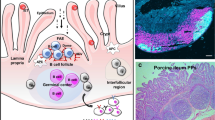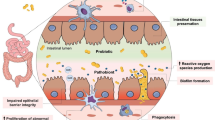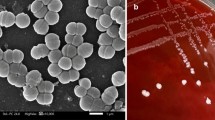Abstract
T-2 toxin is a worldwide problem for feed and food safety, leading to livestock and human health risks. The objective of this study was to explore the mechanism of T-2 toxin-induced small intestine injury in broilers by integrating the advanced microbiomic, metabolomic and transcriptomic technologies. Four groups of 1-day-old male broilers (n = 4 cages/group, 6 birds/cage) were fed a control diet and control diet supplemented with T-2 toxin at 1.0, 3.0, and 6.0 mg/kg, respectively, for 2 weeks. Compared with the control, dietary T-2 toxin reduced feed intake, body weight gain, feed conversion ratio, and the apparent metabolic rates and induced histopathological lesions in the small intestine to varying degrees by different doses. Furthermore, the T-2 toxin decreased the activities of glutathione peroxidase, thioredoxin reductase and total antioxidant capacity but increased the concentrations of protein carbonyl and malondialdehyde in the duodenum in a dose-dependent manner. Moreover, the integrated microbiomic, metabolomic and transcriptomic analysis results revealed that the microbes, metabolites, and transcripts were primarily involved in the regulation of nucleotide and glycerophospholipid metabolism, redox homeostasis, inflammation, and apoptosis were related to the T-2 toxin-induced intestinal damage. In summary, the present study systematically elucidated the intestinal toxic mechanisms of T-2 toxin, which provides novel ideas to develop a detoxification strategy for T-2 toxin in animals.






Similar content being viewed by others
Data availability
All data generated or used during the study appear in the this article.
References
Benítez-Páez A, Gómez Del Pugar EM, López-Almela I, Moya-Pérez Á, Codoñer-Franch P, Sanz Y (2020) Depletion of Blautia species in the microbiota of obese children relates to intestinal inflammation and metabolic phenotype worsening. mSystems 5(2):e00857-19
Chi MS, Mirocha CJ, Kurtz HJ, Weaver G, Bates F, Shimoda W (1977) Subacute toxicity of T-2 toxin in broiler chicks. Poult Sci 56(1):306–313
Diaz GJ, Vargas ML, Cortés A (2016) Evaluation of the supplementation of a feed additive as a potential protector against the adverse effects of 2.5 ppm T-2 toxin on growing broiler chickens. Arq Bras Med Vet Zootec 68(3):709–715.
Dong TT, Han RP, Yu JW, Zhu MK, Zhang Y, Gong Y, Li ZY (2019) Anthocyanins accumulation and molecular analysis of correlated genes by metabolome and transcriptome in green and purple asparaguses. Food Chem 271:18–28
D’Souza MS, Luu AN, Guisinger TC, Seelely SL, Waldschmidt RA, Chrissobolis S (2022) RGS5 protein deficiency differentially influences blood pressure, vascular and behavioral effects in aged male mice. J Cardiovasc Pharmacol 80(2):305–313
Edgar RC (2013) UPARSE: highly accurate OTU sequences from microbial amplicon reads. Nat Methods 10(10):996–998
Edrington TS, Kubena LF, Harvey RB, Rottinghaus GE (1997) Influence of a superactivated charcoal on the toxic effects of aflatoxin or T-2 toxin in growing broilers. Poultry Sci 76(9):1205–1211
Fang HB, Cong LZ, Zhi Y, Xu HB, Jia XD, Peng SQ (2016) T-2 toxin inhibits murine ES cells cardiac differentiation and mitochondrial biogenesis by ROS and p-38 MAPK-mediated pathway. Toxicol Lett 258:259–266
Franki T, Salobir J, Rezar V (2008) The effect of vitamin E supplementation on reduction of lymphocyte DNA damage induced by T-2 toxin and deoxynivalenol in weaned pigs. Anim Feed Sci Tech 141(3–4):274–286
Guan S, Gong M, Yin Y, Huang R, Ruan Z, Zhou T, Xie M (2011) Occurrence of mycotoxins in feeds and feed ingredients in China. J Food Agric Environ 9(2):163–167
Han FL, Wang XD, Guo JL, Qi CL, Xu C, Luo Y, Li EC, Qin JG, Chen LQ (2019) Effects of glycinin and β-conglycinin on growth performance and intestinal health in juvenile Chinese mitten crabs (Eriocheir sinensis). Fish Shellfish Immunol 84:269–279
Haskard CA, El-Nezami HS, Kankaanpää PE, Salminen S, Ahokas JT (2001) Surface binding of aflatoxin B1 by lactic acid bacteria. Appl Environ Microbiol 67(7):3086–3091
He K, Zhou HR, Pestka JJ (2012) Mechanisms for ribotoxin-induced ribosomal RNA cleavage. Toxicol Appl Pharmacol 265(1):10–18
Henke MT, Kenny DJ, Cassilly CD, Vlamakis H, Xavier R, Clardy J (2019) Ruminococcus gnavus, a member of the human gut microbiome associated with Crohn’s disease, produces an inflammatory polysaccharide. Proc Natl Acad Sci USA 116(26):12672–12677
Hymery N, Leon K, Carpentier FG, Jung JL, Parent-Massin D (2009) T-2 toxin inhibits the differentiation of human monocytes into dendritic cells and macrophages. Toxicol in Vitro 23:509–519
Joffe AZ (1983) Environmental conditions conducive to Fusarium toxin formation causing serious outbreaks in animals and man. Vet Res Commun 7(1–4):187–193
Kong L, Zhu LJ, Yi XL, Huang Y, Zhao HQ, Chen YZ, Yuan ZH, Wen LX, Wu J, Yi J (2021) Betulinic acid alleviates spleen oxidative damage induced by acute intraperitoneal exposure to T-2 toxin by activating Nrf2 and inhibiting MAPK signaling pathways. Antioxidants (Basel) 10(2):158
Kuno R, Ito G, Kawamoto A, Hirafuri Y, Sugihara HY, Takeoka S, Nagata S, Takahashi J, Tsuchiya M, Anzai S, Mizutani T, Shimizu H, Yui S, Oshima S, Tsuchiya K, Watanabe M, Okamoto R (2021) Notch and TNF-α signaling promote cytoplasmic accumulation of OLFM4 in intestinal epithelium cells and exhibit a cell protective role in the inflamed mucosa of IBD patients. Biochem Biophys Rep 25:100906
Li YS, Wang ZH, Beier RC, Shen JZ, De Smet D, De Saeger S, Zhang SX (2011) T-2 toxin, a trichothecene mycotoxin: Review of toxicity, metabolism, and analytical methods. J Agric Food Chem 59(8):3441–3453
Liao YX, Peng Z, Chen LK, Nussler AK, Liu LG, Yang W (2018) Deoxynivalenol, gut microbiota and immunotoxicity: a potential approach? Food Chem Toxicol 112:342–354
Lin KM, Lin B, Lian IY, Mestril R, Scheffler IE, Dillmann WH (2001) Combined and individual mitochondrial HSP60 and HSP10 expression in cardiac myocytes protects mitochondrial function and prevents apoptotic cell deaths induced by simulated ischemia-reoxygenation. Circulation 103(13):1787–1792
Lin RQ, Sun Y, Ye WC, Zheng T, Wen JK, Deng YQ (2019) T-2 toxin inhibits the production of mucin via activating the IRE1/XBP1 pathway. Toxicology 424:152230
Liu M, Zhang L, Chu XH, Ma R, Wang YW, Liu Q, Zhang NY, Karrow NA, Sun LH (2020) Effects of deoxynivalenol on the porcine growth performance and intestinal microbiota and potential remediation by a modified HSCAS binder. Food Chem Toxicol 141:111373
Liu M, Zhao L, Gong G, Zhang L, Shi L, Dai J, Han Y, Wu Y, Khalil MM, Sun L (2022) Invited review: Remediation strategies for mycotoxin control in feed. J Anim Sci Biotechno 13(1):19
Liu M, Zhang L, Mo Y, Li J, Yang J, Wang J, Karrow NA, Wu H, Sun LH (2023) Ferroptosis is involved in deoxynivalenol-induced intestinal damage in pigs. J Anim Sci Biotech. https://doi.org/10.1186/s40104-023-00841-4
Lun AK, Moran ET Jr, Young LG, McMillan EG (1988) Disappearance of deoxynivalenol from digesta progressing along the chicken’s gastrointestinal tract after intubation with feed containing contaminated corn. Bull Environ Contam Toxicol 40(3):317–324
Luo JJ, Zhang Y, Sun H, Wei JT, Khalil MM, Wang YW, Dai JF, Zhang NY, Qi DS, Sun LH (2019) The response of glandular gastric transcriptome to T-2 toxin in chicks. Food Chem Toxicol 132:110658
Ma R, Zhang L, Liu M, Su YT, Xie WM, Zhang NY, Dai JF, Wang Y, Rajput SA, Qi DS, Karrow NA, Sun LH (2018) Individual and combined occurrence of mycotoxins in feed ingredients and complete feeds in china. Toxins (Basel) 10(3):113
Magne F, Gotteland M, Gauthier L, Zazueta A, Pesoa S, Navarrete P, Balamurugan R (2020) The Firmicutes/Bacteroidetes ratio: a relevant marker of gut dysbiosis in obese patients? Nutrients 12(5):1474
Magoč T, Salzberg SL (2011) FLASH: fast length adjustment of short reads to improve genome assemblies. Bioinformatics 27(21):2957–2963
Mowat AM, Agace WW (2014) Regional specialization within the intestinal immune system. Nat Rev Immunol 14(10):667–685
Mu PQ, Xu M, Zhang L, Wu KX, Wu J, Jiang J, Chen QM, Wang LJ, Tang XQ, Deng YQ (2013) Proteomic changes in chicken primary hepatocytes exposed to T-2 toxin are associated with oxidative stress and mitochondrial enhancement. Proteomics 13(21):3175–3188
Osselaere A, Li SJ, De Bock L, Devreese M, Goossens J, Vandenbroucke V, Van Bocxlaer J, Boussery K, Pasmans F, Martel A, De Backer P, Croubels S (2013) Toxic effects of dietary exposure to T-2 toxin on intestinal and hepatic biotransformation enzymes and drug transporter systems in broiler chickens. Food Chem Toxicol 55:150–155
Pinotti L, Ottoboni M, Giromini C, Dell’Orto V, Cheli F (2016) Mycotoxin contamination in the EU feed supply chain: a focus on cereal byproducts. Toxins (Basel) 8(2):45
Reddy NB, Devegowda G, Shashidhara RG (2004) Ability of modified glucomannan to sequestrate T-2 toxin in the gastrointestinal tract of chicken. Asian-Aust J Anim Sci 17(2):259–262
Rizzatti G, Lopetuso LR, Gibiino G, Binda C, Gasbarrimi A (2017) Proteobacteria: a common factor in human diseases. Biomed Res Int 2017:9351507
Sehata S, Kiyosawa N, Atsumi F, Ito K, Yamoto T, Teranishi M, Uetsuka K, Nakayama H, Doi K (2005) Microarray analysis of T-2 toxin-induced liver, placenta and fetal liver lesions in pregnant rats. Exp Toxicol Pathol 57(1):15–28
Singh R, Park S, Koo JS, Kim IN, Balasubramanian B (2020) Significance of varying concentrations of T-2 toxin on growth performance, serum biochemical and hematological parameters in broiler chickens. J Anim Sci Technol 62(4):468–474
Sokolović M, Garaj-Vrhovac V, Simpraga B (2008) T-2 toxin: incidence and toxicity in poultry. Arh Hig Rada Toksikol 59(1):43–52
Sorenson WG, Gerberick GF, Lewis DM, Castranova V (1986) Toxicity of mycotoxins for the rat pulmonary macrophage in vitro. Environ Health Perspect 66:45–53
Stechow LV, Typas D, Puigvert JC, Oort L, Siddappa R, Pines A, Vrieling H, van de Water B, Mullenders LH, Danen EH (2015) The E3 ubiquitin ligase ARIH1 protects against genotoxic stress by initiating a 4EHP-mediated mRNA translation arrest. Mol Cell Biol 35(7):1254–1268
Streit E, Schatzmayr G, Tassis P, Tzika E, Marin D, Taranu I, Tabuc C, Nicolau A, Aprodu I, Puel O, Oswald IP (2012) Current situation of mycotoxin contamination and co-occurrence in animal feed–focus on Europe. Toxins (Basel) 4(10):788–809
Sun LH, Zhang NY, Zhu MK, Zhao L, Zhou JC, Qi DS (2016) Prevention of aflatoxin B1 hepatoxicity by dietary selenium is associated with inhibition of cytochrome P450 isozymes and up-regulation of 6 selenoprotein genes in chick liver. J Nutr 146:655–661
Szabó A, Szabó-Fodor J, Fébel H, Mézes M, Bajzik G, Kovács M (2016) Oral administration of fumonisin B1 and T-2 individually and in combination affects hepatic total and mitochondrial membrane lipid profile of rabbits. Physiol Int 103(3):321–333
Thompson WL, Wannemacher RWJ (1990) In vivo effects of T-2 mycotoxin on synthesis of proteins and DNA in rat tissues. Toxicol Appl Pharmacol 105(3):483–491
Van der Veen JN, Kennelly JP, Wan S, Vance JE, Vance DE, Jacobs RL (2017) The critical role of phosphatidylcholine and phosphatidylethanolamine metabolism in health and disease. Biochim Biophys Acta Biomembr 1859:1558–1572
Wahyuni HI (2000) Histological development and digestive enzyme activities of the gastrointestinal tract of native and commercial broiler chicks (gallus gallus domesticus, linn). zhonghua fu chan ke za zhi 14(1).
Wan D, Wang X, Wu QH, Lin PP, Pan YH, Sattar A, Huang LL, Ahmad I, Zhang YY, Yuan ZH (2015) Integrated transcriptional and proteomic analysis of growth hormone suppression mediated by trichothecene T-2 toxin in rat GH3 cells. Toxicol Sci 147(2):326–338
Wang XC, Liu XD, Liu JC, Wang G, Wan KY (2012) Contamination level of T-2 and HT-2 toxin in cereal crops from Aba Area in Sichuan Province, China. Bull Environ Contam Toxicol 88:396–400
Wang YL, Wang BJ, Liu M, Jiang KY, Wang MQ, Wang L (2018) Aflatoxin B1 (AFB1) induced dysregulation of intestinal microbiota and damage of antioxidant system in pacific white shrimp (Litopenaeus vannamei). Aquaculture 495:940–947
Wang XP, Qi XF, Yang B, Chen SY, Wang JY (2019) RNA-Seq analysis of duck embryo fibroblast cell gene expression during the early stage of egg drop syndrome virus infection. Poult Sci 98(1):404–412
Wang CL, Wang XD, Huang YX, Bu XY, Xiao SS, Qin CJ, Qiao F, Qin JG, Chen LQ (2020) Effects of dietary T-2 toxin on gut health and gut microbiota composition of the juvenile Chinese mitten crab (Eriocheir sinensis). Fish Shellfish Immunol 106:874–882
Wang JS, Jiang J, Zhang HX, Wang JP, Cai H, Li C, Li KB, Liu J, Guo XJ, Zou GX, Wang DZ, Deng YQ, Dai JY (2011) Integrated transcriptional and proteomic analysis with in vitro biochemical assay reveal the important role of CYP3A46 in T-2 toxin hydroxylation in porcine primary hepatocytes. Mol Cell Proteomics 10(9):M111.008748.
Wang ZR, Cui YY, Vainstein A, Chen SW, Ma HQ (2017) Regulation of fig (L.) fruit color: metabolomic and transcriptomic analyses of the flavonoid biosynthetic pathway. Front Plant Sci 8:1990.
Wei JT, Wu KT, Sun H, Khalil MM, Dai JF, Liu Y, Liu Q, Zhang NY, Qi DS, Sun LH (2019) A novel modified Hydrated Sodium Calcium Aluminosilicate (HSCAS) adsorbent can effectively reduce T-2 toxin-induced toxicity in growth performance, nutrient digestibility, serum biochemistry, and small intestinal morphology in chicks. Toxins (Basel) 11(4):199
Wu W, Zhou HR, Bursian SJ, Link JE, Pestka JJ (2016) Emetic responses to T-2 toxin, HT-2 toxin and emetine correspond to plasma elevations of peptide YY3-36 and 5-hydroxytryptamine. Arch Toxicol 90(4):997–1007
Wu QH, Wang X, Nepovimova E, Miron A, Liu QY, Wang Y, Su DX, Yang HL, Li L, Kuca K (2017) Trichothecenes: immunomodulatory effects, mechanisms, and anti-cancer potential. Arch Toxicol 91(12):3737–3785
Wu J, Yang CL, Liu J, Chen JX, Huang C, Wang J, Liang ZE, Wen LX, Yi JE, Yuang ZH (2019) Betulinic acid tttenuates T-2-toxin-tnduced testis oxidative damage through regulation of the JAK2/STAT3 signaling pathway in mice. Biomolecules 9(12):787
Xu JR, Zhao ZH, Guo WB, Ling R, Wang JH, Wang XC, Yang JH (2022) Potential role of individual and combined effects of T-2 toxin, HT-2 toxin and neosolaniol on the apoptosis of porcine leydig cells. Toxins (Basel) 14(2):145
Yang J, Zhao Z, Guo W, Guo J (2017) Effects of deoxynivalenol on intestinal microbiota of mice analyzed by Illumina-MiSeq High-Throughput Sequencing technology. Chin J Anim Nutr 29:1
Yang JY, Zhang YF, Li YX, Meng XP, Bao JF (2018) L-arginine protects against oxidative damage induced by T-2 toxin in mouse Leydig cells. J Biochem Mol Toxicol 32(10):e22209
Yang LC, Tu D, Wang ND, Deng ZB, Zhan Y, Liu W, Hu Y, Liu TB, Tan L, Li YL, Guo SY, Wang AB (2019) The protective effects of dl-Selenomethionine against T-2/HT-2 toxins-induced cytotoxicity and oxidative stress in broiler hepatocytes. Toxicol in Vitro 54:137–146
Yang JH, Guo WB, Wang JH, Yang XL, Zhang ZQ, Zhao ZH (2020) T-2 toxin-induced oxidative stress leads to imbalance of mitochondrial fission and fusion to activate cellular apoptosis in the human liver 7702 cell line. Toxins (Basel) 12(1):43
Yin HD, Han SS, Chen YQ, Wang Y, Li DY, Zhu Q (2020) T-2 toxin induces oxidative stress, apoptosis and cytoprotective autophagy in chicken hepatocytes. Toxins (Basel) 12(2):90
Yuan ZH, Matias FB, Yi JE, Wu J (2016) T-2 toxin-induced cytotoxicity and damage on TM3 Leydig cells. Comp Biochem Physiol C Toxicol Pharmacol 181–182:47–54
Zhai SS, Ruan D, Zhu YW, Li MC, Ye H, Wang WC, Yang L (2020) Protective effect of curcumin on ochratoxin A-induced liver oxidative injury in duck is mediated by modulating lipid metabolism and the intestinal microbiota. Poult Sci 99(2):1124–1134
Zhang YF, Yang JY, Li YK, Zhou W (2017) Toxicity and oxidative stress induced by T-2 toxin in cultured mouse Leydig cells. Toxicol Mech Methods 27(2):100–106
Zhang XL, Wang YC, Yang X, Liu ML, Huang WY, Zhang J, Song M, Shao B, Li YF (2021) The nephrotoxicity of T-2 toxin in mice caused by oxidative stress-mediated apoptosis is related to Nrf2 pathway. Food Chem Toxicol 149:112027
Zhang YN, Liu H, Lin XL, Zhang F, Meng PL, Tan SJ, Lammi MJ, Guo X (2021) Dysregulation of cells cycle and apoptosis in human induced pluripotent stem cells chondrocytes through p53 pathway by HT-2 toxin: an in vitro study. Front Genet 12:677723
Zhang XL, Xu BY, Hou ZP, Xie CL, Niu YR, Dai QZ, Yan XH, Wu DQ (2022) Dietary ε-polylysine affects on gut microbiota and plasma metabolites profiling in mice. Front Nutr 9:842686
Zhao L, Feng Y, Deng J, Zhang NY, Zhang WP, Liu XL, Rajput SA, Qi DS, Sun LH (2019) Selenium deficiency aggravates aflatoxin B1-induced immunotoxicity in chick spleen by regulating 6 selenoprotein genes and redox/inflammation/apoptotic signaling. J Nutr 149(6):894–901
Zhao L, Zhang L, Xu Z, Liu X, Chen L, Ji D, Karrow NA, Sun L (2021) Occurrence of aflatoxin B1, deoxynivalenol and zearalenone in feeds in China during 2018–2020. J Anim Sci Biotechno 12(1):74
Zhou F, Liu BD, Liu X, Li Y, Wang LL, Huang J, Luo GZ, Wang XY (2021) The impact of microbiome and microbiota-derived sodium butyrate on drosophila transcriptome and metabolome revealed by multi-omics analysis. Metabolites 11(5):298
Acknowledgements
This research was funded by the Open Project of the Key Laboratory of Animal Embryo Engineering and Molecular Breeding of Hubei Province (KLAMEMB-2017-05); the National Key Research and Development Program of China, Project (2016YFD0501207 and 2018YFD0500601); and a gift from Jiangsu Aomai Bio-technology Co., Ltd.
Author information
Authors and Affiliations
Contributions
LHS and JTW designed the research; ML, LZ, JTW, and YXH conducted the experiments and analyzed the data; LM, ZL, and LHS wrote the paper; MMK, WDW, KK help review and edit the paper; LHS had the primary responsibility for the final content. All authors read and approved the final manuscript.
Corresponding authors
Ethics declarations
Conflict of interest
The authors declare that they have no known competing financial interests or personal relationships that could have appeared to influence the work reported in this paper.
Additional information
Publisher's Note
Springer Nature remains neutral with regard to jurisdictional claims in published maps and institutional affiliations.
Supplementary Information
Below is the link to the electronic supplementary material.
Rights and permissions
Springer Nature or its licensor (e.g. a society or other partner) holds exclusive rights to this article under a publishing agreement with the author(s) or other rightsholder(s); author self-archiving of the accepted manuscript version of this article is solely governed by the terms of such publishing agreement and applicable law.
About this article
Cite this article
Liu, M., Zhao, L., Wei, JT. et al. T-2 toxin-induced intestinal damage with dysregulation of metabolism, redox homeostasis, inflammation, and apoptosis in chicks. Arch Toxicol 97, 805–817 (2023). https://doi.org/10.1007/s00204-023-03445-z
Received:
Accepted:
Published:
Issue Date:
DOI: https://doi.org/10.1007/s00204-023-03445-z




